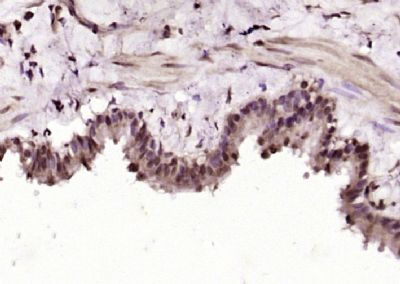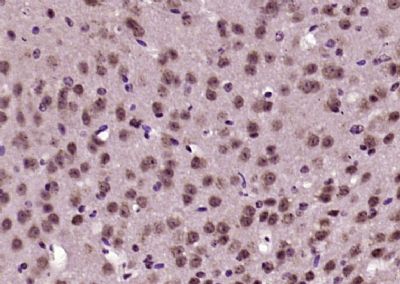IKAP Polyclonal Antibody
Purified Rabbit Polyclonal Antibody (Pab)
- SPECIFICATION
- CITATIONS
- PROTOCOLS
- BACKGROUND

Application
| WB, IHC-P, IHC-F, IF, ICC, E |
|---|---|
| Primary Accession | O95163 |
| Reactivity | Rat |
| Host | Rabbit |
| Clonality | Polyclonal |
| Calculated MW | 150 KDa |
| Physical State | Liquid |
| Immunogen | KLH conjugated synthetic peptide derived from human IKAP |
| Epitope Specificity | 1151-1250/1332 |
| Isotype | IgG |
| Purity | affinity purified by Protein A |
| Buffer | 0.01M TBS (pH7.4) with 1% BSA, 0.02% Proclin300 and 50% Glycerol. |
| SUBCELLULAR LOCATION | Cytoplasm. Nucleus. |
| SIMILARITY | Belongs to the ELP1/IKA1 family. |
| SUBUNIT | Component of the RNA polymerase II elongator complex (Elongator) made of at least six subunits, ELP1/ELO2, ELP2, ELP3/ELO3, ELP4/ELO1, ELP5, and ELP6. |
| DISEASE | Defects in IKBKAP are the cause of hereditary sensory and autonomic neuropathy type 3 (HSAN3) [MIM:223900]; also known as Riley-Day syndrome or familial dysautonomia (FD). This autosomal recessive disorder is due to the poor development and survival, and progressive degeneration of the sensory, sympathetic and parasympathetic neurons. HSAN3 individuals are affected with a variety of symptoms such as decreased sensitivity to pain and temperature, cardiovascular instability, recurrent pneumonias, vomiting crises, and gastrointestinal dysfunction. It is primarily confined to individuals of Ashkenazi Jewish descent, with an incidence of 1/3'600 live births. |
| Important Note | This product as supplied is intended for research use only, not for use in human, therapeutic or diagnostic applications. |
| Background Descriptions | The transcription factor NFkB is retained in the cytoplasm in an inactive form by the inhibitory protein IkB. Activation of NFkB requires that IkB be phosphorylated on specific serine residues, which results in the targeted degradation of IkB (1). IkB kinase alpha (IKK alpha), previously designated CHUK (2), interacts with IkB-alpha and specifically phosphorylates IkB-alpha on the sites that trigger its degradation, serines 32 and 36 (3). IKKalpha appears to be critical for NFkB activation in response to proinflammatory cytokines (4). Phosphorylation of the IkB by IKK alpha is stimulated by the NFkB inducing kinase (NIK), which itself is a central regulator for NFkB activation in response to TNF and IL-1 (5). The functional IKK complex contains three subunits, IKK alpha, IKK beta and IKK gamma (also designated NEMO), and each appears to make essential contributions to IkB phosphorylation (6). IKAP (IKK-complex-associated protein) is a protein that acts as a scaffold, interacting with NIK, IKK alpha and IKK beta and assembling them into an active kinase complex (7,8) |
| Gene ID | 8518 |
|---|---|
| Other Names | Elongator complex protein 1, ELP1, IkappaB kinase complex-associated protein, IKK complex-associated protein, p150, ELP1 (HGNC:5959) |
| Target/Specificity | Expressed in meristematic tissues of in roots, stems, leaves, seedlings, cotyledons, guard cells, floral buds, flowers, siliques, and shoot apices. |
| Dilution | WB=1:500-2000,IHC-P=1:100-500,IHC-F=1:100-500,ICC=1:100-500,IF=1:100-500,ELISA=1:5000-10000 |
| Format | 0.01M TBS(pH7.4), 0.09% (W/V) sodium azide and 50% Glyce |
| Storage | Store at -20 ℃ for one year. Avoid repeated freeze/thaw cycles. When reconstituted in sterile pH 7.4 0.01M PBS or diluent of antibody the antibody is stable for at least two weeks at 2-4 ℃. |
| Name | ELP1 (HGNC:5959) |
|---|---|
| Function | Component of the elongator complex which is required for multiple tRNA modifications, including mcm5U (5-methoxycarbonylmethyl uridine), mcm5s2U (5-methoxycarbonylmethyl-2-thiouridine), and ncm5U (5-carbamoylmethyl uridine) (PubMed:29332244). The elongator complex catalyzes the formation of carboxymethyluridine in the wobble base at position 34 in tRNAs (PubMed:29332244). Regulates the migration and branching of projection neurons in the developing cerebral cortex, through a process depending on alpha-tubulin acetylation (By similarity). ELP1 binds to tRNA, mediating interaction of the elongator complex with tRNA (By similarity). May act as a scaffold protein that assembles active IKK-MAP3K14 complexes (IKKA, IKKB and MAP3K14/NIK) (PubMed:9751059). |
| Cellular Location | Cytoplasm. Nucleus |

Thousands of laboratories across the world have published research that depended on the performance of antibodies from Abcepta to advance their research. Check out links to articles that cite our products in major peer-reviewed journals, organized by research category.
info@abcepta.com, and receive a free "I Love Antibodies" mug.
Provided below are standard protocols that you may find useful for product applications.
If you have used an Abcepta product and would like to share how it has performed, please click on the "Submit Review" button and provide the requested information. Our staff will examine and post your review and contact you if needed.
If you have any additional inquiries please email technical services at tech@abcepta.com.













 Foundational characteristics of cancer include proliferation, angiogenesis, migration, evasion of apoptosis, and cellular immortality. Find key markers for these cellular processes and antibodies to detect them.
Foundational characteristics of cancer include proliferation, angiogenesis, migration, evasion of apoptosis, and cellular immortality. Find key markers for these cellular processes and antibodies to detect them. The SUMOplot™ Analysis Program predicts and scores sumoylation sites in your protein. SUMOylation is a post-translational modification involved in various cellular processes, such as nuclear-cytosolic transport, transcriptional regulation, apoptosis, protein stability, response to stress, and progression through the cell cycle.
The SUMOplot™ Analysis Program predicts and scores sumoylation sites in your protein. SUMOylation is a post-translational modification involved in various cellular processes, such as nuclear-cytosolic transport, transcriptional regulation, apoptosis, protein stability, response to stress, and progression through the cell cycle. The Autophagy Receptor Motif Plotter predicts and scores autophagy receptor binding sites in your protein. Identifying proteins connected to this pathway is critical to understanding the role of autophagy in physiological as well as pathological processes such as development, differentiation, neurodegenerative diseases, stress, infection, and cancer.
The Autophagy Receptor Motif Plotter predicts and scores autophagy receptor binding sites in your protein. Identifying proteins connected to this pathway is critical to understanding the role of autophagy in physiological as well as pathological processes such as development, differentiation, neurodegenerative diseases, stress, infection, and cancer.



